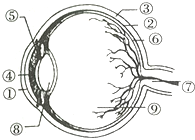如图是人的眼球结构模式图,请根据图分析回答下列问题:
(1)外界物体反射来的光线经过眼球各部分的结构折射到图中的[⑥]______上的感光细胞形成物像,然后通过视神经传递到______形成视觉.
(2)正常人的眼睛通过调节图中的[⑧]______的曲度以看清远近不同的物体,而患近视眼时则需要配戴______透镜加以矫正.

眼球由眼球壁和内容物组成,眼球壁包括外膜、中膜和内膜,外膜前面由无色透明的①角膜和后面白色坚韧的③巩膜组成;中膜由④虹膜、⑤睫状肌和②脉络膜组成,前面是虹膜,虹膜不透光有黑色素,俗称黑眼球,白种人是蓝色的,俗称蓝眼睛;内膜是含有感光细胞的⑥视网膜,可以形成物像;内容物由房水、⑧晶状体、⑨玻璃体组成.晶状体似双凸透镜,对光线有折射作用,可以使远近不同的物体反射来的光线都能落在视网膜上.虹膜中央有瞳孔,瞳孔的大小可以调节,能够控制进入眼球内的光线.玻璃体是透明的胶状物,最大.
(1)视觉形成的过程是:外界物体反射来的光线,经过①角膜、房水,由瞳孔进入眼球内部,再经过⑧晶状体和⑨玻璃体的折射作用,在⑥视网膜上能形成清晰的物像,物象刺激了视网膜上的感光细胞,这些感光细胞产生的神经冲动,沿着视神经传到大脑皮层的视觉中枢,就形成视觉.
(2)看近处物体时,必须通过⑤睫状肌的收缩作用,使晶状体的凸度增加,使近处的物体像能够落在视网膜上,才能看的清楚.
如果长时间的近距离作业,如读书、写字、看电视、玩游戏机等,使眼睛长时间的调节紧张,头部前倾,眼球内不断的充血,眼内压相应的增高,以及眼外肌的紧张和压迫眼球,或者因调节时牵引涡状静脉,妨碍了血液的流通,使巩膜的抵抗力减弱,导致晶状体过度变凸,不能恢复成原状;严重时使眼球的前后径过长,使远处物体反射来的光线形成的物像,落在视网膜的前方,因此不能看清远处的物体.形成近视.需要佩戴凹透镜进行矫正.
故答案为:
(1)视网膜视觉中枢(或大脑一定区域)
(2)[⑧]晶状体凹
